This article was originally published in 2018 and has been updated with subsequent releases, including Clint Eastwood’s latest film, Juror No. 2.
Clint Eastwood has reinvented himself many times over the course of a career that now stretches back over 60 years, but it’s usually taken time for everyone else to catch up with the changes. After working as a bit player for years — he first pops up in the uncharacteristic role of a lab technician in the 1955 monster movie Revenge of the Creature — Eastwood found TV stardom as Rowdy Yates on the long-running Western series Rawhide. Then, at a time when TV stars had trouble transitioning to film work, he found movie stardom via an unconventional route, traveling to Europe to appear as a character later known as the Man With No Name in three Westerns by Italian director Sergio Leone: A Fistful of Dollars, For a Few Dollars More, and The Good, the Bad and the Ugly.
Those films became worldwide hits that made Eastwood into a big-screen icon, but just as soon as he’d shaken off his TV-star image, he found he wanted more. With his money from those movies, Eastwood formed the Malpaso Company (later Malpaso Productions), with an eye toward exerting more control over the material in which he appeared — and eventually directing, which he began doing with the 1971 thriller Play Misty for Me.
Though he’s often intertwined the two strands of his career, it’s directing more than acting that’s been Eastwood’s focus ever since, even if the public and the press tended to treat it as a sideline hobby during the early years. Eastwood was the Man With No Name and Dirty Harry first; everything else came second. By the time Eastwood had started to be accepted as a proficient director of genre movies thanks to The Outlaw Josey Wales and The Gauntlet, his ambitions had already deepened, as had his commitment to making movies that explored and toyed with his own big-screen image.
That phase reached a kind of culmination with the 1992 film Unforgiven, a Western of undeniable artistic achievement that would go on to win the Best Picture Oscar, and the years that followed found Eastwood redoubling his efforts to pursue whatever project appealed to him. Now 94, he’s been prolific and unpredictable ever since, turning out films that have ranged from police thrillers to melodramas to an old-fashioned musical.
Nobody turning out films at Eastwood’s pace can be great all the time. He likes to work fast with little rehearsal and few takes, often operating from screenplays still in the same shape they were in when the draft first landed on his desk, now an anomaly in an industry that loves rewrites, reshoots, and market-tested ideas. Sometimes the approach produces classics, sometimes it doesn’t. But it’s impossible to trace a pattern of decline. Eastwood remains capable of producing a stunner after a string of underwhelming efforts. And even the weakest Eastwood films have their compelling qualities in part because, while no one was paying attention, Eastwood learned to be a great director. Like Don Siegel, a collaborator Eastwood studied as he started to consider making his own film, Eastwood works like a craftsman. Every shot and every camera move matters, and if the work isn’t showy at every moment, Eastwood has a habit of building to an image of eerie power or disarming beauty that reveals just how much thought he’s given to what he’s doing — even if he’s thinking and making decisions faster than the average director.
With the release of Juror #2, Eastwood’s 40th film, we took the occasion to rank his films as a director, sticking strictly to those with which he’s credited as a director. (By all reports, Eastwood assumed the reins of the 1984 thriller Tightrope, for instance. The reason: The original director was working too slowly, a cardinal sin in the world of a filmmaker always ready to move on to what’s next.)
40. The Rookie (1990)
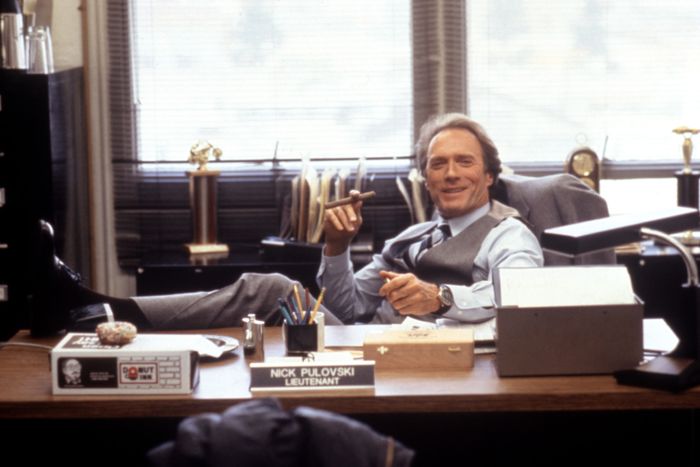
Photo: Warner Bros./Everett Collection
The closest item to a purely mercenary effort in Eastwood’s filmography, The Rookie finds him trying to keep pace with Lethal Weapon, Die Hard, and other adrenaline-fueled action films of the era. Eastwood plays an aging cop who teams up with the eponymous rookie, a rich kid played by Charlie Sheen. The stars don’t have much chemistry, there’s an uncomfortable scene in which Sônia Braga’s bad guy sexually assaults a bound Eastwood, and a couple of decent action sequences can’t redeem the rest. Even this basement dweller is never less than watchable, but why choose it when there are much better options?
39. Firefox (1982)
Another attempt to keep up with commercial trends, Firefox arrived packaged as a state-of-the-art techno thriller in which Eastwood’s Major Mitchell Grant, a Vietnam vet reluctantly called back into service, is sent behind the Iron Curtain to steal a futuristic Soviet jet. But Eastwood doesn’t take to the skies until the home stretch of what’s otherwise an overlong, relentlessly talky espionage thriller, and even then the special effects by the great John Dykstra vary wildly in quality. The film gets some points for having Grant suffering from PTSD and haunted by his war experiences, which introduces some ambiguity to its smash-the-commies plot, but there’s otherwise not much of interest here.
38. Breezy (1973)
Undoubtedly Eastwood’s least-seen film, his third feature depicts the romance between a divorced real-estate agent (William Holden) and a free-spirited hippie (Kay Lenz). The relationship always feels more creepily paternal than transgressive, Eastwood has trouble finding much momentum, and the film’s idea of sexual liberation mostly involves Lenz taking her shirt off a lot while Holden looks on sleepily. Universal didn’t know what to do with the film and effectively buried it. It’s intriguing as a time capsule of early-’70s Los Angeles, but not much else.
37. Jersey Boys (2014)
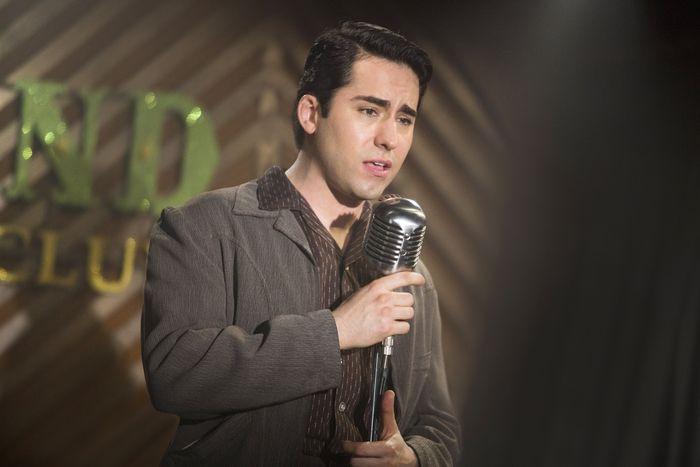
Photo: Keith Bernstein/Warner Bros./Everett Collection
Eastwood spent much of the early-’10s circling around a new version of A Star Is Born, a project that, you may have heard, would eventually be taken over by his friend Bradley Cooper. So instead of moving forward with a version that at one point might have starred Beyoncé and Tom Cruise (or Leonardo DiCaprio and Esperanza Spalding), Eastwood shot this perfectly functional version of the long-running jukebox musical that tells the story of ’60s hit-makers Frankie Valli and the Four Seasons in song. Nothing here suggests that Eastwood had been holding out on moviegoers by never making a musical until now.
36. The 15:17 to Paris (2018)
The oddest film in Eastwood’s career, The 15:17 to Paris tells the story of Spencer Stone, Anthony Sadler, and Alek Skarlatos, three Americans whose quick thinking and bravery stopped a terrorist attack on a train bound from Amsterdam to Paris. Eastwood’s film tells the story from the beginning, following the eventual heroes from their childhood, where they’re played by child actors, through adulthood, where Stone, Sadler, and Skarlatos play themselves. Building a whole movie around a few decisive moments isn’t as crazy as it might sound; Eastwood had done it a few years earlier in Sully, a film higher up this list. But why give over so much of the film to scenes of the three leads just touring through Europe in the lead-up to the attack? Still, while the leads aren’t exactly naturals in front of the camera, their presence gives the movie a weird energy, as does the casting of so many comedy-friendly actors (Jenna Fischer, Judy Greer, Jaleel White) in the childhood scenes. It doesn’t really work, but you won’t see another movie like it.
35. The Eiger Sanction (1975)
Eastwood stars as Jonathan Hemlock, an art historian, mountain climber, and former assassin who’s called out of retirement against his will to take out a bad guy in the Swiss Alps. A mostly stupid movie that seems aware of its own absurdity, it does boast one highlight: the climbing sequences, which feature Eastwood doing his own stunts. Still, Eastwood was ill-suited to play an international man of mystery, and he seems to be aware of it. Apart from Firefox, he’d wisely leave stories of spy craft to others in the years to come.
34. J. Edgar (2011)
A great American epic that just doesn’t quite work, this J. Edgar Hoover biopic follows the career of the FBI director from its early days until Hoover’s 1972 death, by which time he’d become one of the most powerful men in America. Working from a script by Milk writer Dustin Lance Black, Eastwood doesn’t shy away from exploring Hoover’s opaque sexuality, nor does the firmly right-leaning director ignore Hoover’s abuses of power. But the film, though handsomely mounted, is all over the place, recounting the Lindbergh kidnapping one moment, Hoover’s attempts to blackmail Martin Luther King Jr. the next, and that lack of focus never allows the big story it wants to tell to emerge. Also not helping matters: a shout-y performance from Leonardo DiCaprio as Hoover and unconvincing old-age makeup that becomes a constant distraction in scenes set later in Hoover’s life.
33. Absolute Power (1997)
A strong cast — Eastwood and Laura Linney are especially good — and typically solid direction can’t elevate this unremarkable thriller with a remarkable premise. Eastwood plays a jewel thief who witnesses the president of the United States (Gene Hackman) killing his mistress. The film hits the expected beats but, in spite of its milieu and a William Goldman script, doesn’t really have much to say about power, absolute or otherwise.
32. True Crime (1999) & 31. Blood Work (2002)
Absolute Power began a trend for Eastwood, who apparently began scanning airport paperback and mystery best sellers in search of material, beginning in the mid-’90s. That would pay off in a major way a few years later with Mystic River, but getting there meant getting through films like True Crime and Blood Work first. The former finds Eastwood playing a reporter trying to determine the guilt or innocence of a man on death row in an adaptation of an Andrew Klavan novel. Blood Work finds him adapting a Michael Connelly best seller in which an FBI agent investigates a serial killer after a heart transplant. Eastwood stars in both, and both suffer from some of the late-career languors that started to creep into his movies after a certain point, mostly due to a tendency to let dialogue scenes play on and on without much regard to rhythm or pace. Both are perfectly acceptable, but neither is ever extraordinary.
30. American Sniper (2014)
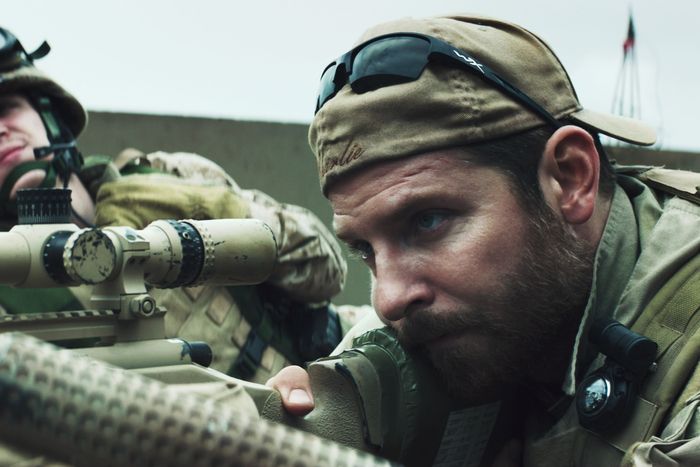
Photo: Warner Bros./Everett Collection
Adapting a memoir by Navy SEAL sniper Chris Kyle — who logged 160 confirmed kills during ten years of service, including a long stretch in Iraq, before being killed by a troubled Marine on a shooting range back home — Eastwood seems torn between making a riveting action movie and exploring the toll of war on those who fight them. Ultimately, the film ends up doing neither with any depth, though it’s elevated by Bradley Cooper’s soulful performance, which suggests more going on behind his character’s eyes than he can bring himself to say out loud. The film became a huge hit, but it’s among the least probing of Eastwood’s war movies.
29. Midnight in the Garden of Good and Evil (1997)
Eastwood’s take on a different sort of best seller, John Berendt’s recounting of a murder among the elite of Savannah, Georgia, Midnight in the Garden of Good and Evil finds Eastwood trucking to the modern South and exploring both a real-life mystery and the local color. Yet Eastwood’s pace allows a bit too much time to soak it all in, and the setting becomes more memorable than the central story. An unrestrained performance from Kevin Spacey doesn’t help matters, though the film’s more misfire than disaster.
28. Invictus (2009)
The same deliberate pacing of Midnight sometimes gets in the way of another true story, this time that of a memorable year for the South African rugby team, whose 1995 World Cup victory provided the country with a crucial moment of unity in the years after the abolishment of apartheid. Matt Damon plays Francois Pienaar, the captain of the mostly white team, who’s inspired by his relationship with the country’s president, Nelson Mandela (Morgan Freeman). It’s not the deepest exploration of recent history, but Damon and Freeman are both terrific and the highlights are quite memorable, including some exciting rugby scenes and a moving sequence in which Pienaar and his team visit the cell that Mandela called home just a few years earlier.
27. Hereafter (2010)
Damon and Eastwood teamed up again for the director’s next film, an unusual supernatural drama in which Damon plays a man tortured by his ability to communicate with the departed loved ones of others. His is just one of three stories that unfold over the course of the film, the others belonging to a French TV journalist shaken by a near-death experience (Cécile de France), and a London boy struggling to recover from the death of his twin brother. Scripted by Peter Morgan (Frost/Nixon, The Queen), the film’s often more ponderous than profound (though it has some ardent admirers). Even so, it features some of Eastwood’s moodiest visuals — shot, like each of Eastwood’s films since 2002, by cinematographer Tom Stern — and there’s a stretch in the middle in which Damon’s character embarks on a tenuous romance with a lonely woman played by Bryce Dallas Howard that’s some of the best work either actor has ever done.
26. The Gauntlet (1977)
The Eiger Sanction seemingly gave Eastwood a taste for over-the-top action, which he continues to indulge in a film where he plays a hard-living cop tasked with escorting a mob trial witness (Sondra Locke) from Las Vegas to Phoenix. Along the way, he falls in love and starts to realize he’s part of a setup. Loud, fast-paced, and bullet-riddled, it now plays like the seed from which a lot of ’80s and ’90s action films grew. If nobody seems that deeply invested in the film personally, everyone appears to be enjoying themselves anyway.
25. Sudden Impact (1983)
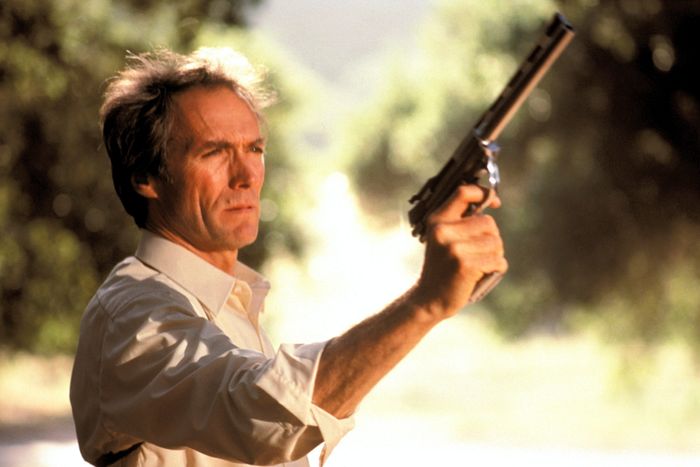
Photo: Warner Bros./Everett Collection
From 1971 through 1988, Eastwood starred in five films as “Dirty” Harry Callahan, a San Francisco cop with no use for authority and an itchy trigger finger. He only directed one of them, however: This fourth outing, which revived the character after a seven-year absence and mixes the shoot-first-ask-questions-later approach to law enforcement with goofy humor — it’s a great film for fans of farting bulldogs — and a rape revenge plot that doesn’t hide its sympathies for Jennifer Spence (Sondra Locke, Eastwood’s frequent co-star and his offscreen partner at the time), the woman knocking off the men who attacked her and her sister years ago. Its opening scenes feel like Eastwood doing his best riff on Hitchcock (or at least Brian De Palma), and while the film can’t sustain that intensity, it’s the best of the sequels by a good margin, and one of the most pronounced examples of a recurring theme found in many an Eastwood film: the awfulness of how men treat women and the justifiable anger that creates.
24. Flags of Our Fathers (2006)
As part of one of his most ambitious projects, Eastwood released two films about the Battle of Iwo Jima in 2006, one from the perspective of the American soldiers, and one from the Japanese. The American-side entry, Flags of Our Fathers, came first, and it’s the lesser of the two largely because its companion piece is such a stunning achievement. That doesn’t mean this one should be overlooked, however. Adapting James Bradley and Ron Powers’s nonfiction book of the same name, the film focuses on three American soldiers involved in the battle, and the raising of the flag at Mount Suribachi, a moment immortalized in a famous photograph and Arlington’s Marine Corps Memorial sculpture. That the image we know was in fact a second flag-raising, re-creating the moment for a photo op after the secretary of the Navy claimed the first flag as a trophy, is central to what Eastwood is doing in the film, which depicts war as both a military and a PR campaign. Lauded for the heroism while still grappling with their experiences, the soldiers find the latter has its casualties as well.
23. Pale Rider (1985)
Eastwood has appeared in many Westerns but he’s only directed four, which range from the quite good to the masterful. The least of these, Pale Rider falls squarely on the “quite good” end of the spectrum, mostly because it’s overshadowed by other films. Eastwood plays the mysterious “Preacher,” seemingly a spirit of vengeance who drifts into a small California mining village harassed by a powerful mining family, who will come to regret their greed. It’s not quite as otherworldly as High Plains Drifter, not quite as emotionally rich as The Outlaw Josey Wales, and its plot owes an awful lot to Shane. But even the least of Eastwood’s Western efforts demonstrates a remarkable understanding of how the genre works, what it means to the American identity, and how he fits into it as an actor and director.
22. Heartbreak Ridge (1986)
In 1983 the United States invaded the Caribbean island nation of Grenada, a brief military action that had already been largely forgotten by the time this big-screen depiction hit screens a few years later. Wisely, the film understands it has to be about more than just the invasion of Grenada, which provides the film with its final act and serves as a capstone to the story of long-serving Gunnery Sergeant Thomas Highway (Eastwood) and his attempts to whip an undisciplined bunch of new Marines into shape. Eastwood’s fun as a profane, no-bullshit soldier whose men hate him until they come to love him, and the film effectively depicts how it’s men like Highway, more than the brass above him, that give the military its character. It’s also the first instance of a theme that would become more prominent in subsequent films: how one generation gives way to the next. Letting his age become central to his character, he plays a man on the verge of retirement, wondering about his legacy, what he’s accomplished, what he’s given up, and what comes next.
21. Play Misty for Me (1971)
Eastwood made his directorial debut with this effective thriller in which he plays Dave Garver, a slick jazz DJ who makes the mistake of starting a relationship with an obsessive fan (Jessica Walter). Working on a modest budget on his home turf in Northern California, Eastwood proved himself an effective director from the start, crafting a tense thriller about the consequences of toying with the wrong woman’s affections — and, it’s worth noting, making it long before Fatal Attraction turned films about obsessed stalkers into a virtual subgenre. The film served both as proof that Eastwood could deliver the commercial goods and a signal that he had ambitions as an artist, thanks to a side trip to the Monterey Jazz Festival and a memorably florid sequence set to Roberta Flack’s “The First Time Ever I Saw Your Face.”
20. Space Cowboys (2000)
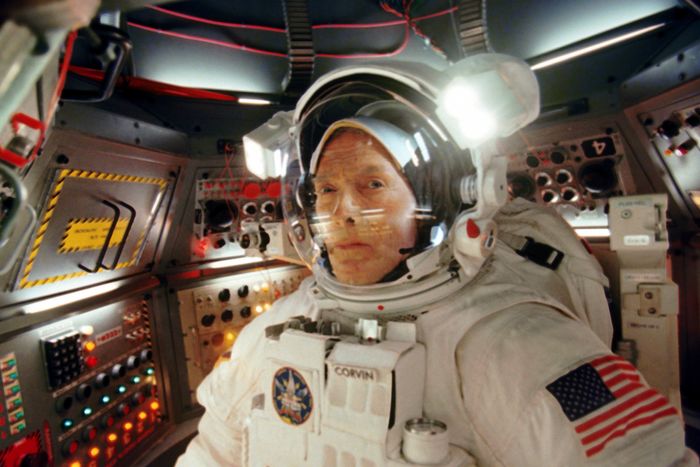
Photo: Warner Bros./Everett Collection
Eastwood also seems to understand how he fits into a certain generation of movie stars — and that that generation would inevitably slip into the past. Space Cowboys rounds up an all-star cast of actors of a certain age, teaming Eastwood with James Garner, Tommy Lee Jones, and Donald Sutherland in a story of four aging Air Force pilots who never got a chance to go to space but are called out of retirement to stop a Cold War–era Soviet satellite threatening to fall to Earth. The story’s thin and the beats predictable, but the cast is a delight, and a creeping sense of poignance deepens a film that celebrates a particular generation of Americans while also acknowledging that their time was running out and new ways, new people, and new ideas would soon take their place — a theme carried over from Heartbreak Ridge that he’d revisit again a few years later.
19. White Hunter Black Heart (1990)
Eastwood clearly had 20th-century icons on his mind as the ’80s turned into the ’90s. For this 1990 adaptation of Peter Viertel’s autobiographical novel, Eastwood assumes the role of John Wilson, a larger-than-life movie director determined to bag an elephant while shooting a film in Africa. Jeff Fahey co-stars as Pete Verrill in a barely disguised account of Viertel’s experiences accompanying John Huston as he made The African Queen. Finding a middle ground between Huston’s unmistakable voice and his own distinctive growl, Eastwood works at the far edges of his range as an actor here, but the performance works anyway in a film that’s more a critique of a certain kind of macho bravado — as embodied by Huston but also by Eastwood himself — than a celebration of it. “There are times in life when you can’t wonder whether this is the right or a wrong thing to do,” Wilson says, and the film doesn’t shy away from the darker implications of where that sort of thinking leads. Overlooked at the time, it provided an early sign that Eastwood planned to keep challenging himself in the years that would follow.
18. Richard Jewell (2019)
There’s so much to admire about Eastwood’s film about Richard Jewell, the story of the security guard who unfairly became a suspect after discovering a bomb at the Atlanta Summer Olympics in 1996, that it’s a shame that one element threatens to overshadow its virtues. So let’s get that out of the way first: Richard Jewell depicts Atlanta Journal-Constitution reporter Kathy Scruggs (Olivia Wilde), who broke the story the FBI was investigating Jewell, sleeping with an FBI source (Jon Hamm) in order to get a story. Both the paper and those who knew Scruggs have protested this depiction, and it’s ironic that a film about the horror of wrongful accusations would participate in the same. Get past this, and past the sense the story gives the libertarian Eastwood a chance to grind axes with the government and the media, and you’ll find a moving character study of an unlikely hero that doubles as a depiction of how a man’s world could collapse through no fault of his own. Affectingly played by Paul Walter Hauser, Jewell emerges as frustrating and overzealous — the sort of man alternately prone to amuse and frustrate those around him — but also a person of good intentions who’s made to suffer for a courageous and selfless act. Sam Rockwell, as a down-on-his luck lawyer, and Kathy Bates, as Jewell’s protective mother, round out the cast as the only people to stand by Jewell as he transforms from media darling to public enemy seemingly overnight.
17. Changeling (2008)
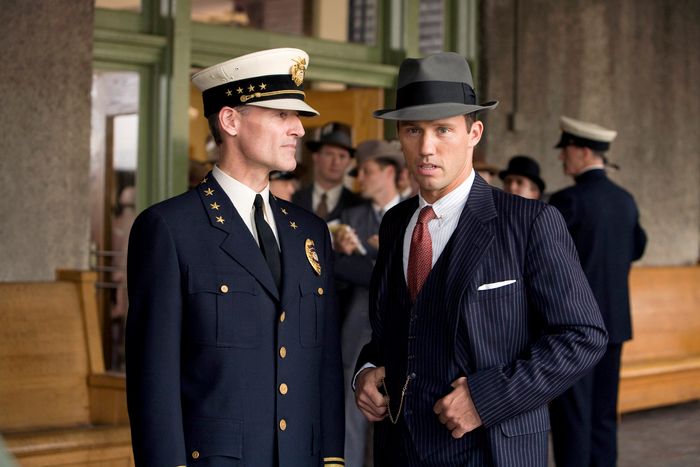
Photo: Universal/Everett Collection
Set in 1920s Los Angeles and based on a strange, infuriating true story, Changeling stars Angelina Jolie as Christine Collins, a single mother whose 9-year-old son goes missing. Months later, the Los Angeles Police Department unites mother and child — only there’s something wrong. Christine insists that the child isn’t hers and, despite medical evidence backing up her claims, she’s institutionalized when she insists that she’s been given the wrong boy. To say more would spoil the film’s twists, even though the twists aren’t really the point of the film; it’s more concerned about what it means to be a woman made powerless by a corrupt, patriarchal system that doesn’t mind exploiting stereotypes about female instability. Jolie is perfectly cast, and though the film loses steam in its final stretch, it’s a haunting, still-relevant depiction of how authority gets abused and how institutions let suffering fall on the vulnerable.
16. Cry Macho (2021)
Filmmakers have attempted to adapt N. Richard Nash’s 1975 novel Cry Macho pretty much since it was published. Potential past stars included Robert Mitchum, Arnold Schwarzenegger, Roy Scheider, and even Clint Eastwood, who came close making it decades earlier but opted to make The Dead Pool instead. While it might have been nice to have been spared the last and least of Dirty Harry’s adventures, the film Eastwood ended up making decades later suggests waiting was the right idea. Now 91, Eastwood looks the part of a man considering the weight of his choices at the end of his life. He plays Mike Milo, a former rodeo star hired by a former boss to retrieve the boss’s 13-year-old son Rafo (Eduardo Minett) from Mexico. They run into some adventures during the trip, but the film mostly focuses on the ongoing transformative, barely acknowledged conversation between the old man and the boy, one in which Mike shows by example that being the tough guy Rafo fancies himself isn’t all it’s cracked up to be. It’s a sweet film, but one with a sneaky amount of depth to it. Eastwood still has the trademark intimidating scowl but he’s playing a man who wants to leave all the anger and frustration that formed that scowl behind.
15. Honkytonk Man (1982)
Eastwood has had a long, far-from-casual relationship with music. At the height of his Rawhide fame, he released the 1959 album Rawhide’s Clint Eastwood Sings Cowboy Favorites. He appeared in the troubled musical Paint Your Wagon without embarrassing himself. He’s an accomplished pianist with a lifelong interest in jazz and he composed the spare, lovely scores for films like Mystic River and Million Dollar Baby.
It’s not hard to picture an alternate universe in which he pursued that passion instead. With Honkytonk Man, Eastwood cast himself as a doomed, fictional, Depression-era singer Red Stovall. A lifelong plugger with a drinking problem and a worsening case of tuberculosis, he sees an invitation to audition for the Grand Ole Opry as his last shot at glory and hits the road for Nashville with the assistance of his 14-year-old nephew Whit (Eastwood’s son Kyle Eastwood). The film eschews melodrama for a pleasantly rambling journey that captures the fullness of Stovall’s ramshackle life as it builds to a heartbreaking finale, a tribute to those whose voices were silenced before they could really be heard. Kyle Eastwood’s quite good in a demanding role, but, unlike several of Eastwood’s other children, he opted not to go into acting. He became a musician instead.
14. Bird (1988)
Honkytonk Man was overlooked in 1982, but that didn’t dissuade Eastwood from depicting the life of another tragic musician a few years later. Breaking with jazz orthodoxy in the mid-’40s, Charlie Parker pioneered bebop and helped clear the terrain jazz would explore for the next few decades. But he struggled with addiction throughout his career, and those addictions cut his life short. Eastwood’s biopic doesn’t reinvent the form, but its stately, respectful approach avoids exploiting or glamorizing Parker’s struggles and steers clear of clichés about addiction and genius being inextricable. He also, wisely, lets much of the film rest on the shoulders of star Forest Whitaker, who finds the humanity within the icon.
13. The Mule (2018)
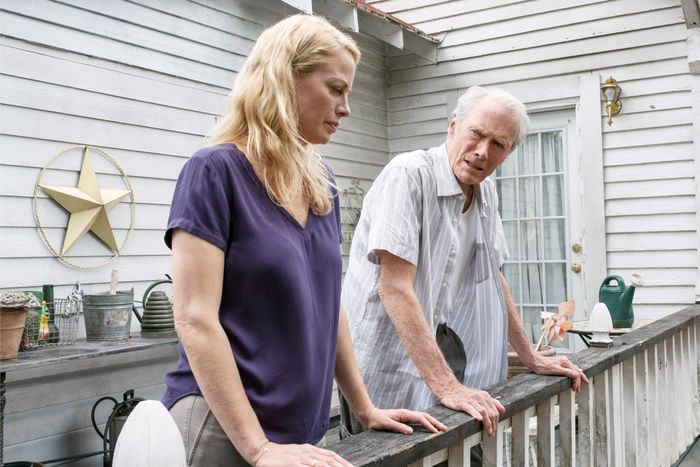
Photo: Claire Folger/Warner Bros./Everett Collection
Directing a film that he also stars in for the first time since 2008’s Gran Torino, Eastwood here casts himself as Earl Stone, a 90-year-old horticulturist who hits hard times and starts running drugs for a cartel. As an FBI Agent (Bradley Cooper) closes in on him, Earl grapples with a life spent neglecting his family and wondering if it’s not too late to make amends — all while charming a bunch of hardened drug dealers and complaining about how the kids these days depend on their cell phones too much. Reuniting with Gran Torino screenwriter Nick Schenk for a fact-based story, Eastwood again plays a man staring down death and trying to figure out what really counts. And yet the movie’s surprisingly fun — and Eastwood in particular is an irascible delight — even as it sorts through the moral murk of the drug business and considering what it takes to stay afloat in an unforgiving American economy.
12. High Plains Drifter (1973)
Eastwood’s second film as a director, and his first Western, finds him reprising a variation on his Man With No Name character playing, yes, a nameless man who travels to a remote mining town and takes the job of defending it from a band of outlaws — while only later revealing that he has an agenda of his own. Eastwood and Bruce Surtees, his go-to cinematographer through the mid-’80s, fill the eerie, atmospheric film — written by Shaft creator Ernest Tidyman — with haunting images, particular as the protagonist’s true intentions become clear. (The film’s relentless darkness extends, fair warning, to an early rape scene that’s very much the product of the same queasy cultural moment that produced Straw Dogs.)
11. Mystic River (2003)
A film of almost unfathomable sadness, this adaptation of Dennis Lehane’s Boston-set novel explores the roles of chance and fate in reshaping lives while depicting how the past never really lets go of its hold on the future. At its core, it’s a murder mystery, but it’s less interested in the twists and turns of a crime story than in tracing the destructive aftershocks caused by the murder of Katie Markum (Emmy Rossum), the daughter of ex-con Jimmy Markum (Sean Penn). Jimmy runs a corner store in the neighborhood, where he grew up alongside Sean (Kevin Bacon) and Dave (Tim Robbins). Sean’s become a cop, Dave’s never really recovered from a boyhood kidnapping in which he was taken from the streets while Jimmy and Sean were left behind, and the lives of the three men intersect as the mystery of Katie’s death deepens. Penn and Robbins’s big, bold, deeply accented performances sometimes threaten to topple the film over, but soul-deep mournfulness and a strong sense of place keep it grounded. It’s a film about how ghosts linger and how the places that made us keep their hold on us, whether we stay or leave.
10. Gran Torino (2008)
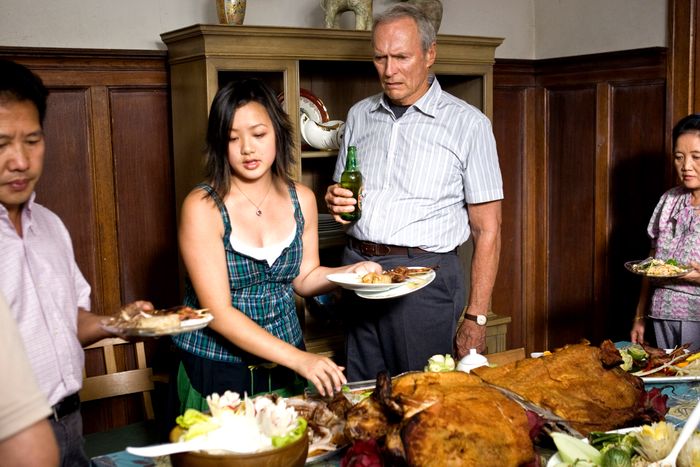
Photo: Warner Bros./Everett Collection
To talk about Clint Eastwood inevitably means talking about his politics, which can be tough to pin down. A self-declared libertarian, he supports gun laws, has expressed opposition to most of the wars since World War II, and has no issues with gay marriage. At one point in the 1980s, he was giving money both to groups backing the Equal Rights Amendment and to Bo Gritz, a former Special Forces officer who reinvented himself as a mercenary determined to find the POWs he believed to still be alive in Vietnam. He doesn’t have a lot of use for government involvement in most aspects of everyday life, summing up his views to Ellen DeGeneres as “leave everybody alone.” (None of which stopped him from making an embarrassing appearance at the 2012 Republican Convention in which he talked to an empty chair.)
Eastwood also doesn’t have a lot of use for liberal pieties, which probably helps explain his attraction to Walt Kowalski, the hero of his 2008 film Gran Torino. A retired Detroit autoworker happy to spout ethnic slurs, a tendency the film tries to explain away in one scene as just how guys of a certain generation talk. That sort of justification is tough to swallow, whether in real life or on film. It’s also not really the point of Gran Torino, in which Walt’s actions matter more than his words. Those actions involve befriending Thao Vang Lor (Bee Vang), a Hmong teenager he catches reluctantly trying to steal his beloved 1972 Ford Gran Torino under pressure from a local gang. The relationship changes both Walt and Thao, and the film offers the fullest expression of one of Eastwood’s key enduring interests: what changes and what remains when one generation gives way to the next. For all the expressed bigotry of its protagonist, the film clearly sees America as a big tent with room for all.
9. Juror No. 2 (2024)
Juror #2 arrived amid rumors it will be Eastwood’s final film. Don’t be surprised if it’s not. Though he’s now deep into his 90s, Eastwood doesn’t seem to be bound by the limitations of mere mortals. Final or not, Juror #2 never plays like the work of a director who’s grown weary or lost a step. Working from a sharp script by Jonathan Abrams, Eastwood once again rolls an examination of morality, justice, and guilt into a compelling genre movie. In this case, it’s a legal thriller with a strange twist. Nicholas Hoult stars as Justin, an affable everyman who’s summoned for jury duty at a murder trial only to realize that he, not the accused, may be responsible for the victim’s death. (It sounds more implausible in description than in the film.) Toni Collette co-stars as Faith, a prosecutor with an election on the line who needs a big win. As the trial unfolds, both find themselves in the midst of ethical and moral struggles as the patient, gripping film explores the nature of virtue and guilt, and the question of how much we’re willing — or should be asked — to sacrifice in order to do the right thing.
8. Bronco Billy (1980)
Eastwood made a fortune for Warner Bros. in 1978 starring alongside an orangutan in the genial bare-knuckled comedy Every Which Way But Loose. He used part of the capital he accumulated to pursue quirky projects like Bronco Billy, a big-hearted film about the motley crew behind a low-rent, old-fashioned, but spirited traveling Wild West show. Eastwood stars as “Bronco” Billy McCoy, an expert in trick-riding and rope-twirling who’s filled with good advice for the young “pardners” that make up the most enthusiastic members of his never-particularly-large audiences. Sondra Locke co-stars again, this time as a snooty heiress forced to travel with the show — and who eventually learns not only that Billy used to sell shoes in New Jersey, but that the rest of the troupe aren’t exactly products of the Wild West either. Eastwood tweaks his persona and takes Old West clichés to their absurd extreme, but he doesn’t mock either. The film celebrates America as a place where even the corniest icons play a role in shaping our values and anyone can reinvent themselves as the person they want to be — and should.
7. A Perfect World (1993)
After the success of Unforgiven Eastwood helmed another exploration of what justice means in America via the story of “Butch” Haynes (Kevin Costner), an escaped convict in early ’60s Texas who kidnaps Phillip, a sheltered 8-year-old boy (T.J. Lowther), then finds himself forming an unexpected bond with his fatherless hostage. Eastwood co-stars as a set-in-his-ways Texas Ranger assigned to work with Sally Gerber (Laura Dern), a criminologist aiding the manhunt whose empathetic views force him to reconsider his own past with Butch. Written by John Lee Hancock (The Blind Side), the meditatively paced film swims in the ambiguity of Butch’s character, and features one of Costner’s best performances. Costner plays Butch as a man who never really had a chance, one capable of tremendous understanding and tenderness, but just as capable of visiting horrors on those he meets, and while the film asks tough questions about where the responsibility lies for how such a man came to be — and what’s to be done with him. Eastwood and Dern have some great moments together — it’s yet another film in which Eastwood plays a man challenged to rethink his assumptions by the next generation — but it’s the bond between Butch and Phillip that makes the film so compelling, and ultimately so haunting.
6. Sully (2016)
How do you dramatize the story of Chesley “Sully” Sullenberger, the airline pilot who, after losing both engines to a flock of birds, safely landed his plane in the Hudson River in 2009? It’s a remarkable story but also a fairly short one. Birds hit plane. Pilot lands plane. Everyone lives. We’re done. With Sully, Eastwood and screenwriter Todd Komarnicki use the incident as a focal point to which the film keeps circling back, treating it as the few telling moments to which Sully’s moments have been building, and which would define the rest of his life. In full Everyman mode, Tom Hanks plays Sully as a man whose heroism and professionalism are inextricable. That remarkable landing is just an extension of a lifetime of trying to get the job done, one that involves leaving behind any trouble he might be having at home or any impulse to panic. The film stretches the truth by making the National Transportation Safety Board’s subsequent investigation into what looks like an inquisition out to take down a good man, but the dramatic device allows the film to put those decisive moments under the microscope as it returns to them again and again, examining Sully’s thinking and finding quiet dignity in scenes of a man just doing his job the best he can under impossibly trying circumstances.
5. The Outlaw Josey Wales (1976)
Anyone wanting to pinpoint the moment when Eastwood came into his own as an artist should start here. But first, it’s worth mentioning the film’s troubled origins. It’s an adaptation of the book The Rebel Outlaw: Josey Wales (a.k.a. Gone to Texas) by Forrest Carter, the pen name of Asa Earl Carter who would go on to write the hoax memoir The Education of Little Tree, the invented story of his upbringing by Cherokee grandparents. Carter would go on to be exposed as a white supremacist Klan member who once wrote speeches for George Wallace, and whether his literary career was an attempt to distance himself from that, an opportunistic exercise, or some combination of the two remains an unsettled question. The film began production under Philip Kaufman, but when he and Eastwood fell out, Eastwood fired him from the film, leading the DGA to create “the Eastwood rule,” prohibiting anyone involved with the production of the film from firing and taking over for a director.
For all that, The Outlaw Josey Wales is anything but the fruit of a poisoned tree. Eastwood plays the title character, a man reluctantly drawn into the Confederate side of the Civil War after the slaughter of his family. Refusing to surrender, he goes lights out for Texas, picking up notoriety as a famous outlaw as he accumulates a kind of makeshift family that includes a Cherokee chief (Chief Dan George), some ill-fated Kansas settlers, and others. The film doubles as a study of a man who’s given up on life only to find himself drawn back into it by needs of others; Josey wants to be alone, but the world has other plans for him. It’s as filled with violence as any Eastwood Western, but at its heart it’s a call for compassion and reconciliation after a moment of great division — a theme that found particular resonance in the years after the Vietnam War.
4. The Bridges of Madison County (1995)
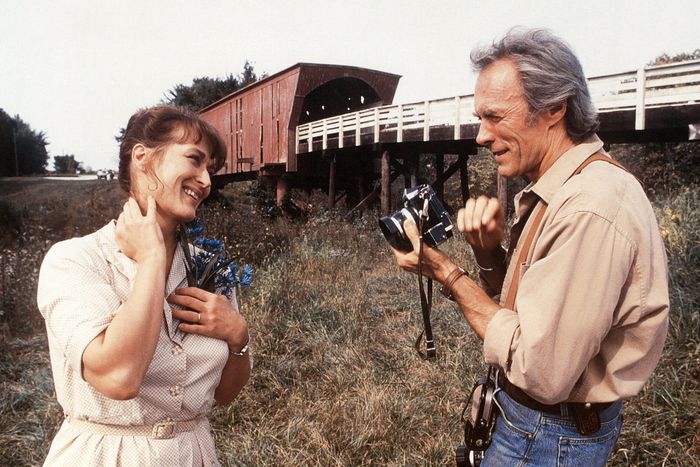
Photo: Warner Bros./Everett Collection
Robert James Waller’s 1992 novel The Bridges of Madison County had critics rolling their eyes, but it became an unstoppable best seller anyway. Maybe the book was just waiting to be adapted into a great movie, as some books are. (Ever read The Godfather? It’s not such a hot piece of writing either.) Working from a Richard LaGravenese script, Eastwood turned it into one of his best films, even if getting to the great parts means getting past a creaky framing device in which a pair of siblings sort through the possessions of their dead mother Francesca, an Italian war bride who started a new life in Iowa. There they discover evidence of a long-ago affair between their mother and a National Geographic photographer named Robert Kincaid. Cut to a flashback set in the mid-’60s where a moving, slow-burning romance unfolds. Meryl Streep and Eastwood play the central couple, whose relationship deepens as they tour a set of photogenic bridges. Eastwood had rarely let himself be this vulnerable onscreen before and he generates extraordinary chemistry with Streep, who plays a woman rediscovering passions she thought she left behind years before. The film tells a simple story simply, focusing on the stirring desires of its characters — and their growing understanding that acting on those desires might leave them heartbroken.
3. Letters From Iwo Jima (2006)
The second half of Eastwood’s Iwo Jima diptych considers the battle from the perspective of the Japanese soldiers who entrenched themselves in tunnels and fought to the death against the invading force. As in Flags of Our Fathers, Eastwood is just as interested in the individual lives of the men doing fighting, and the political forces that brought them to the battlefield, as the combat itself. Here, that involves following a soldier at the highest possible level — General Tadamichi Kuribayashi (Ken Watanabe) — and a grunt — PFC Saigo (Kazunari Ninomiya) — as the battle intensifies and it becomes increasingly clear that it cannot be won. Eastwood’s films match a respect for the military with a distaste for war and the callousness of officers who treat their soldiers as cogs. It’s filled with horrific images of life in the tunnels, where just waiting to die in awful conditions became its own kind of torture; the film emphasizes the experiences of soldiers who were treated as cannon fodder by those in command. And though it works on its own, it’s even better as a companion to Flags of Our Fathers, the shift in perspective suggesting that the experience of war remains the same for soldiers regardless of the cause. Eastwood insists on finding humanity everywhere, even in the most dehumanizing circumstances.
2. Million Dollar Baby (2004)
A heartbreaker, Million Dollar Baby begins as a propulsive underdog sports story about a cantankerous boxing trainer named Frankie (Eastwood) and an up-and-coming fighter named Maggie (Hilary Swank) who insists he train her. Against Frankie’s instincts, but with the encouragement of longtime co-worker “Scrap-Iron” Dupris (Morgan Freeman, who also narrates), Frankie agrees and they meet with great success — and then tragedy strikes. An old-fashioned melodrama refitted for the 21st century, it’s beautifully acted by Eastwood, Swank, and Freeman, playing characters who form a familial bond as they work toward a common goal and seek to patch over the broken places in their lives. Eastwood directs with a confidence that the emotions of the piece — adapted from stories written by a boxing trainer who wrote under the name F.X. Toole — will be enough to compel viewers to stay with the film even as the possibility of a happy ending drifts out of view. The film won multiple Oscars: Best Picture, Best Director for Eastwood, Best Actress for Swank, and Best Supporting Actor for Freeman — all well-deserved.
1. Unforgiven (1992)
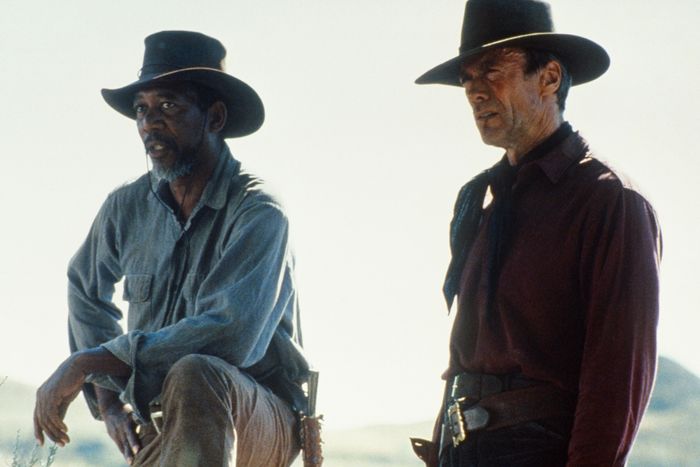
Photo: Warner Bros./Everett Collection
In the early ’80s, Eastwood came into the possession of a screenplay written by David Webb Peoples called The Cut-Whore Killings. Against the advice of long-serving Malpaso story editor Sonia Chernus, who called it “trash” and objected to its rampant profanity, he decided to make it — just not right away. Later telling biographer and friend Richard Schickel that he thought “age would be a benefit,” he waited until time caught up with him; it allowed him to convincingly play the part of William Munny, once a feared killer, now a widower trying to live a good life as a humble pig farmer. But need beckons when disease strikes his livestock, so he heads off with the loudmouthed, inexperienced “Schofield Kid” (Jaimz Woolvett) and erstwhile gunsling partner Ned Logan (Morgan Freeman) in search of some cowboys who mutilated a prostitute, to collect a sizable bounty offered by the victim’s fellow prostitutes. Standing in their way are the ruthless bounty hunter English Bob (Richard Harris); Sheriff “Little” Bill Daggett (Gene Hackman); and Munny’s conscience, which aches at the crimes he once committed and at the thought of committing more.
Unforgiven works first as gripping Western, but it’s also a meditation on violence (both as a part of pop culture and American history), Eastwood’s onscreen persona, sin, and the possibility that we’ll never find redemption on Earth. It’s the perfect film made at just the right time and, to date and likely forever, Eastwood’s farewell to the genre that made him. It earned him his first Oscar nominations and his first wins, for Best Picture and Best Director (joined by a Best Supporting Actor award for Hackman and a Best Editing trophy for Joel Cox). Respect at last, but did it matter? In the end, for Eastwood, it’s always about the work, and there’s always another movie to make.
